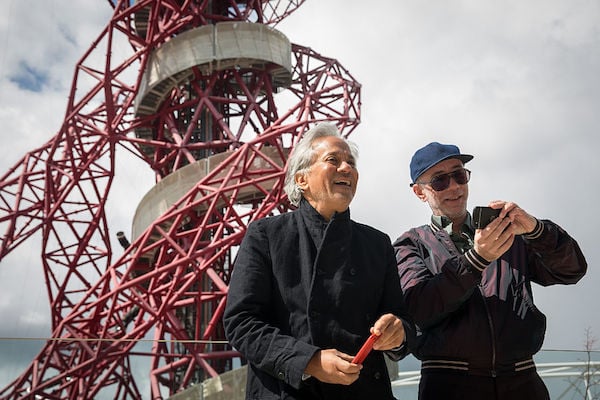
Yesterday, tickets for the world’s longest and tallest slide—an attraction that combines the talents of two of the most popular visual artists today, Anish Kapoor and Carsten Höller—went up for sale ahead of its opening to the public on June 24.
Höller’s 584-foot-long spiraling slide is being fitted over Kapoor’s ArcelorMittal Orbit tower in London’s Olympic Park—which, when completed in 2012 at a cost of £19 million ($27 million), became the UK’s tallest public artwork.
However, during a visit alongside Höller to review progress on the construction works yesterday, Kapoor revealed that he was resistant to the idea at first, and that the revamp project was “foisted” upon him by London mayor Boris Johnson with the goal of making the tower more profitable, the Guardian reports.
Several media reports suggest that Johnson might have had good reasons to rethink the commercial strategy of the attraction.
After the 2012 Olympic Games, the Orbit tower was used as an observation tower, running at a loss of £520,000 ($884,000) in 2014–15, according to the BBC—or losing up to £10,000 ($17,000) a week in 2014, according to the Guardian.
Artist’s impression of the Orbit Tower as a slide
Photo: via @AMOrbit Twitter.
But Kapoor has said that Johnson’s request “felt to me as if it was turning the whole thing in the wrong direction.”
“It was not always my thinking. The mayor foisted this on the project and there was a moment where I had to make a decision—do I go to battle with the mayor or is there a more elegant or astute way through this?,” he told the Guardian.
“I knew of Carsten’s work so I thought, well, who better than a fellow artist to join up with and make this a positive story rather than a negative… Luckily, and thankfully, Carsten was open to it, so we found a way round this,” Kapoor explained.
Judging by the unforgettable success of Höller’s slide installation at Tate Modern’s Turbine Hall 10 years ago, it’s easy to imagine what made Kapoor click and extend the invitation to the Belgian-born Stockholm-based artist.
With adult tickets costing £15–17 ($21–24) to visit the tower and go down the slide, the attraction will surely be entering a more profitable phase, although Kapoor told reporters he wished the entrance fee “was cheaper, frankly.”
“One makes artworks for other reasons than profit,” he told the Guardian. “I understand this is run as a so-called attraction, which I have problems with personally… I want it to be slightly more highbrow than that, without wanting to be pompous about it. There’s a difference between a fairground ride and art,” he added.
Artist’s impression of the Orbit Tower as a slide
Photo: via @AMOrbit Twitter.
Höller, meanwhile, took a more lighthearted approach, urging people to embrace “the amusement side of it.”
“A child might be here purely for the slide, while the serious art lover might see this in purely formalistic terms. I personally like the confusion, that you don’t know what it is but it still creates a very unique experience,” he told the Guardian.
The ever-opinionated Kapoor, though, also seized the moment to make a pro-Europe plea, when asked whether he would vote for the UK to stay in the EU in the upcoming referendum.
“Most certainly, this is a good European collaboration between the two of us,” he said, while pointing at Höller, the Belfast Telegraph reports. “[Leaving Europe] will certainly have an effect on our ability, outside of Europe, to make projects like this, so we pray and hope and work to stay in.”
“We are hoping Boris [Jonhson] will be the first one down, and that this will still be Europe when he gets to the bottom,” he wittily remarked, alluding to the referendum’s date, June 23, just a day the before the slide opens to the public.